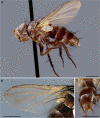A world review of the bristle fly parasitoids of webspinners
- PMID: 37170177
- PMCID: PMC10127400
- DOI: 10.1186/s40850-022-00116-x
A world review of the bristle fly parasitoids of webspinners
Abstract
Background: Dipteran parasitoids of Embioptera (webspinners) are few and extremely rare but known from all biogeographical regions except Australasia/Oceania. All belong to the fly family Tachinidae, a hyperdiverse and widespread clade of parasitoids attacking a variety of arthropod orders.
Results: The webspinner-parasitizing Diptera are reviewed based mostly on records from the collecting and rearing by Edward S. Ross. A new genus is erected to accommodate a new Afrotropical species, Embiophoneus rossi gen. et sp. nov. The genus Perumyia Arnaud is reviewed and a new species, Perumyia arnaudi sp. nov., is described from Central America while P. embiaphaga Arnaud is redescribed and new host records are given. A new species of Phytomyptera Rondani, P. woodi sp. nov., is described from Myanmar, representing the first report of a member of this genus obtained from webspinners. The genus Rossimyiops Mesnil is reviewed, R. longicornis (Kugler) is redescribed and R. aeratus sp. nov., R. fuscus sp. nov. and R. rutilans sp. nov. are newly described from the Oriental Region, and an updated key to species is given.
Conclusions: Webspinners were probably colonized independently at least four times by tachinids shifting from other hosts, most likely Lepidoptera.
Keywords: Diptera; Embioptera; New species; Parasitoids; Polyneoptera; Tachinidae; Trophic shift.
© 2022. The Author(s).
Conflict of interest statement
The authors declare that they have no competing interests.
Figures













References
-
- Miller KB. The genus- and family-group names in the Embioptera (Insecta) Zootaxa. 2009;2055:1–34. doi: 10.11646/zootaxa.2055.1.1. - DOI
-
- Montagna M, Jun Tong K, Magoga G, Strada L, Tintori A, Ho SYW, Lo N. Recalibration of the insect evolutionary time scale using Monte san Giorgio fossils suggests survival of key lineages through the end-Permian extinction. Proc R Soc B. 2019;286:20191854. doi: 10.1098/rspb.2019.1854. - DOI - PMC - PubMed
-
- Miller KB, Edgerly SE. Systematics and natural history of the Australian genus Metoligotoma Davis (Embioptera: Australembiidae) Invertebr Syst. 2008;22:329–344. doi: 10.1071/IS07018. - DOI
-
- Edgerly JS. Biodiversity of Embiodea. In: Foottit RG, Adler PH, editors. Insect biodiversity: science and society. Chichester: John Wiley & Sons; 2018. pp. 219–244.
-
- Miller KB, Hayashi C, Whiting MF, Svenson GJ, Edgerly JS. The phylogeny and classification of Embioptera (Insecta) Syst Entomol. 2012;37:550–570. doi: 10.1111/j.1365-3113.2012.00628.x. - DOI
LinkOut - more resources
Full Text Sources

